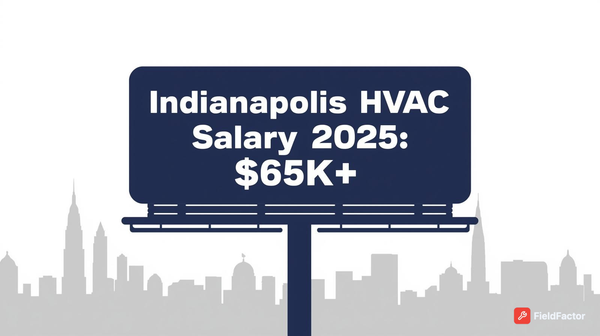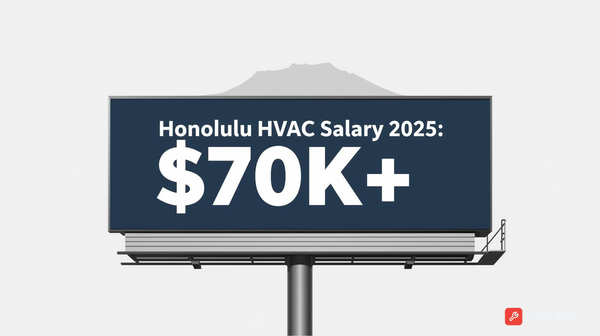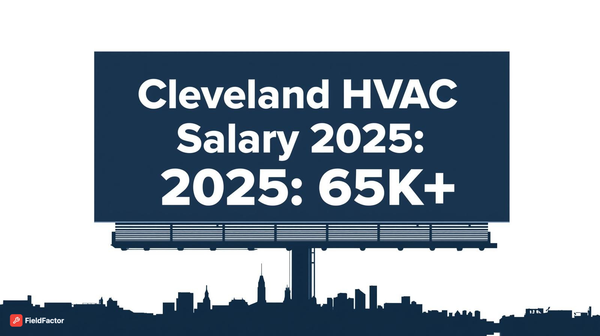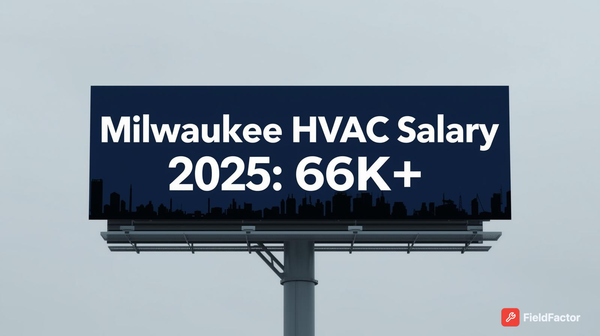One HVAC Claim Can Cost $50K—Here’s the Insurance Every Contractor Needs in 2025
One faulty install or refrigerant leak could wipe out your profits. HVAC claims average $25K–$50K. This 2025 guide breaks down must-have coverage, costs, and top insurers—so you don’t lose your business to a single accident.

Running an HVAC business is high-stakes: A $69.85 billion U.S. market surging to $94.71 billion by 2030 at a 6.28% CAGR, driven by extreme weather, green retrofits, and a 110,000-technician shortage fueling 42,500 annual openings. But one faulty install, refrigerant spill, or worker injury can wipe out your margins—HVAC claims average $25,000-50,000 each, with 25,000+ annual incidents costing the industry $1B+ in losses. In 2025, warmer summers (record heat waves) spike HVAC failures 20-30%, amplifying risks like property damage (39% of claims) and pollution liability.
Insurance isn't bureaucracy—it's your shield. Yet 40% of contractors underinsure, facing $40k+ out-of-pocket hits. This ultimate guide—drawing from BLS, OSHA, ServiceTitan (5,000+ firms), and 2025 insurer data—breaks it down: Essential types (general liability $400-1,200/year), costs (as low as $63/month for basics), requirements (workers' comp mandatory in 50 states), top providers (NEXT at $75/month), and pitfalls (e.g., skipping pollution coverage, 15% of claims). We'll equip you to quote, customize, and claim—saving 20-30% on premiums while sleeping soundly. In a claims-heavy field (2x national injury rate), protect your empire.
Why HVAC Contractor Insurance is Non-Negotiable: Risks, Claims, and Real Costs
HVAC work is hazardous: Electrical shocks, refrigerant leaks, and heavy lifts rack up 25,000+ claims yearly, with 39% tied to equipment failures like improper refrigerant handling. Without coverage, a single lawsuit (e.g., $500k property damage from a faulty install) bankrupts 60% of small firms.
2025 Claims Stats: The Wake-Up Call
| Claim Type | Frequency (% of Total) | Avg. Cost/Claim | Common Causes | Industry Impact |
|---|---|---|---|---|
| Workers' Comp (Injuries) | 40% | $40,000 | Strains/burns (2x national rate) | $1B+ annual payouts; 30% turnover tie. |
| General Liability (Damage) | 35% | $25,000 | Faulty installs, refrigerant spills | 39% equipment failures; $500k+ suits. |
| Property/Theft | 15% | $10,000 | Tool theft, vehicle damage | $5k-15k deductibles; 20% premium hikes. |
| Pollution Liability | 10% | $50,000 | Refrigerant leaks (EPA fines $50k+) | 15% claims; Mandatory in 30 states. |
Data: OSHA/BLS 2024, projected 2025; 25k claims/year, $1B+ costs.
X Voice: "HVAC claim nightmare: $30k refrigerant spill—uninsured, out of business." (Mar 2025). Requirements? General liability ($500k min. in NY) and workers' comp (mandatory if >1 employee) in 50 states; Bonds ($10k-50k) for contracts. Uninsured? 70% face closure after one major claim.
Essential Types of HVAC Contractor Insurance: Coverage Breakdown
HVAC risks demand tailored policies—general liability covers basics, but add-ons like pollution handle refrigerants. Bundle into BOP for 20% savings.
Core Coverage Types: What You Need and Why
| Insurance Type | What It Covers | Why Essential for HVAC | Min. Limits (2025) | Avg. Annual Cost |
|---|---|---|---|---|
| General Liability | Bodily injury/property damage (e.g., $500k install fails, floods home) | 35% claims; Protects against lawsuits (80% HVAC suits). | $500k-$1M | $400-$1,200 ($63/mo avg.) |
| Workers' Compensation | Employee injuries (strains, burns); Medical/lost wages | Mandatory in 50 states if >1 employee; 40% claims, $40k avg. | State-min (e.g., NY $500k) | $1,500-$4,000 ($125/mo) |
| Commercial Auto | Vehicle accidents (e.g., van crash during dispatch) | 15% claims; Covers fleet/tools ($5k-15k losses). | $500k combined | $800-$2,000 ($67/mo) |
| Tools/Equipment Inland Marine | Theft/damage to tools (e.g., $5k compressor stolen) | 20% claims; Mobile work risks. | $10k-50k | $500-$1,000 ($42/mo) |
| Pollution Liability | Refrigerant spills (EPA fines $50k+) | 10% claims; R-410A leaks common. | $1M | $1,000-$3,000 ($83/mo) |
| Professional Liability (E&O) | Errors (e.g., wrong sizing causes $20k inefficiency) | 5% claims; Protects advice-based suits. | $500k | $600-$1,500 ($50/mo) |
| Business Owner's Policy (BOP) | Bundles GL/property (20% savings) | All-in-one for solos/small firms. | $500k GL + $50k property | $1,000-$3,000 ($83-250/mo) |
*Costs for $1M firm, 2-5 employees; Vary by state (FL $65/mo GL vs. NY $500k min.). Sources: NEXT/MoneyGeek 2025.
HVAC Contractor Insurance Costs in 2025: Breakdown by Type, Size, and State
Premiums average $1,500-5,000/year ($125-417/mo), but vary: Solos $63/mo BOP, 10-employee firms $361/mo. Factors: Claims history (+20% hikes), location (NY $500k min. limits), size (more employees = higher workers' comp).
Cost Breakdown: Average Annual Premiums (2025)
| Business Size | General Liability | Workers' Comp | Commercial Auto | Total Bundle (BOP) |
|---|---|---|---|---|
| Solo/1 Employee | $400-$800 | $1,500-$2,500 | $800-$1,200 | $1,000-$3,000 ($83-250/mo) |
| 2-5 Employees | $600-$1,200 | $2,000-$4,000 | $1,000-$2,000 | $2,000-$5,000 ($167-417/mo) |
| 6-10 Employees | $800-$1,500 | $3,000-$6,000 | $1,500-$3,000 | $3,000-$7,000 ($250-583/mo) |
State-by-State Cost Snapshot (Annual, $1M Firm)
| State | Avg. Total Premium | Key Factors | Min. Requirements |
|---|---|---|---|
| Florida | $780 ($65/mo GL) | High claims (hurricanes) | $300k GL |
| New York | $1,500-$3,000 | $500k GL min. | Workers' comp mandatory |
| California | $1,200-$2,500 | Pollution add-ons | $1M GL recommended |
| Texas | $900-$1,800 | Low workers' comp | No state income tax savings |
| National Avg. | $1,500-$5,000 ($125-417/mo) | Clean record = 20% discount | Varies; Bundles save 20%. |
*Sources: NEXT/MoneyGeek/Insureon 2025. Discounts: Clean record 10-20%, bundles 15-25%.
Top HVAC Contractor Insurance Providers in 2025: Reviews and Recommendations
From Insureon/Clutch (4.5+ ratings), these stand out for HVAC—tailored policies, fast claims (90% <30 days).
| Provider | Clutch Rating (2025) | Key Strengths | Avg. Annual Cost | Best For | Drawbacks |
|---|---|---|---|---|---|
| NEXT Insurance | 4.9/5 (2,000 reviews) | Instant quotes, BOP bundles; 24/7 support. | $75-361/mo ($900-4,300/yr) | Solos/small firms; 20% discounts. | Limited add-ons (e.g., cyber). |
| Zensurance | 4.8/5 (1,200 reviews) | HVAC-specific; Fast claims (95% <30 days). | $1,000-3,000 | Canada/Ontario focus; Pollution coverage. | U.S. limited. |
| HUB International | 4.7/5 (900 reviews) | Custom for large firms; Risk consulting. | $2,000-7,000 | Multi-location; Workers' comp bundles. | Higher min. ($5k). |
| Westland Insurance | 4.8/5 (800 reviews) | Affordable BOP; Tools coverage. | $1,200-4,000 | Western U.S.; 15% bundles. | Regional focus. |
| NJM | 4.6/5 (600 reviews) | Liability + auto bundles; NY/PA strong. | $1,500-5,000 | East Coast; Refrigerant pollution. | Fewer reviews. |
*Ranked by reviews/coverage; All offer quotes in 5 min. NEXT wins for affordability (4.9/5).
How to Choose and Get HVAC Contractor Insurance: Step-by-Step 2025 Guide
- Assess Risks: List exposures (e.g., 35% damage claims)—use OSHA checklist.
- Shop Quotes: 3-5 providers (NEXT/Insureon free tools); Compare apples-to-apples ($1M GL).
- Customize: Add pollution ($1M) if refrigerants; Bundle BOP for 20% savings.
- Review Annually: Clean record? 10-20% discounts; Hikes post-claim +20%.
- File Claims: Document (photos, reports); 90% <30 days with digital apps.
Cost-Saving Hack: High deductibles ($1k-5k) cut premiums 15-25%; Safety training lowers 10%.
Common Mistakes: Why 40% of HVAC Contractors Overpay or Underinsure (And Fixes)
- Skipping Pollution: 10% claims, $50k fines—Fix: Add $1M ($1k/year).
- One-Size Policies: Generic skips tools—Fix: Inland marine ($500/year).
- No Bundling: 20% savings lost—Fix: BOP for $1k-3k total.
- Ignoring State Rules: NY $500k min.—Fix: Check CSLB/boards.
Case: Florida contractor's $30k spill claim—uninsured bankruptcy; Insured peer paid $5k deductible.
Conclusion: Arm Your HVAC Empire with the Right Insurance—Quote Today for Peace of Mind
HVAC contractor insurance is your firewall against $25k-50k claims in a $70B market—general liability ($400-1,200) and workers' comp ($1,500-4,000) are musts, bundling BOP for 20% savings. With NEXT leading affordability (4.9/5, $75/mo) and risks like refrigerant spills (10% claims) rising, shop 3 quotes now—protect your $1M milestone. Download our free Insurance Checklist—what's your biggest coverage gap? Comment below.





